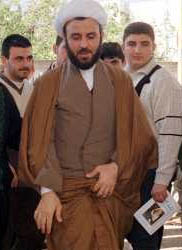Jointly published by the United States Committee for a Free Lebanon and the Middle East Forum
Back to March 2000 Table of Contents
Back to Middle East Intelligence Bulletin homepage.
The Secrets behind Hezbollah's Recent Military Successes
MEIB Staff
After a relative lull in fighting during the last several months of 1999, seven IDF soldiers and twelve SLA soldiers were killed in south Lebanon during the months of January and February. According to information obtained by MEIB military analysts, the series of successful attacks by Hezbollah guerrillas over the last month and a half are attributable in large part to the recent influx of improved weaponry.
 |
| Sheik Nabil Kaouk, Hezbollah's commander in south Lebanon |
Prior to the recent spate of attacks, Hezbollah commandos relied primarily on relatively outdated Soviet-built AT-3 'Sagger' and AT-4 'Spigot' missiles to attack Israeli tanks and armored personnel carriers in the security zone. By the end of last year, however, the IDF had severely curtailed the effectiveness of such close-range attacks by discontinuing tank patrols near the front lines and reinforcing the fortifications of its outposts. In addition, Israeli troops were concentrated in seven outposts deemed to be less vulnerable to attack, leaving the SLA to defend the other eighteen major positions in the security zone.
Over the last few months, however, Damascus decided to permit shipments of more advanced weapons from Hezbollah's Iranian suppliers, including American-made wire-guided TOW anti-tank missiles, which have a longer range and more powerful payload--ironically these weapons had been delivered to Iran by Israel itself during the so-called Irangate scandal in the 1980's.1 At least two attacks since late January involved the use of TOW anti-tank missiles--one against the IDF outpost at Ezziyeh overlooking the Litani river, which killed three Israeli soldiers, and a second at Dabche a few days later, which killed another Israeli soldier. In one attack, Hezbollah guerrillas managed to fire a TOW anti-tank missile through a small slit in a reinforced bunker. Israel has recently attempted to minimize the TOW threat by erecting towers holding 15 meter high mesh nets around IDF and SLA positions.
In addition, Hezbollah reportedly has received shipments of upgraded Katyusha missiles with a 20 km range and al-Fajr missiles with a 70 km range.2 The al-Fajr missiles pose a significantly greater threat than the Katyushas because their extended range enables them to strike major population centers, such as the Mediterranean port of Haifa, Israel's third largest city. However, Hezbollah's commander in south Lebanon, Sheik Nabil Kaouk, cannot order the use of the al-Fajr missiles without authorization from Syrian officials--they are being held as a "strategic reserve" in the event that Damascus chooses to escalate the conflict with Israel to serve its strategic objectives. Although Syria has longer-range missiles that can strike further into Israel, ordering Hezbollah to fire al-Fajr missiles into Israel allows Damascus to claim "plausible deniability" and thus avoid Israeli retaliation against Syrian targets.
In an apparent effort to deprive Syria of "plausible deniability," Israel threatened late last month to target Syrian "interests" in Lebanon if attacks by Hezbollah continue to escalate. "In the ladder of response, there is one step which may bear results -- to take Syrian interests in Lebanon and put them at risk, as they put ours at risk," said Israeli Deputy Defense Minister Ephraim Sneh. "I profoundly hope we would not be obliged to hit Syrian targets, because our policy is to make peace with Syria, not to wage war," he added.3
1 "Inside south Lebanon," Foreign Report, February 2000.
2 "Hezbollah's Aims in Lebanon," Intelligence Newsletter, 2 March 2000.
3 "Israel Threatens Syrian Interests in Lebanon," Reuters, 29 February 2000.
� 2000 Middle East Intelligence Bulletin. All rights reserved.
MEIB Main Page

